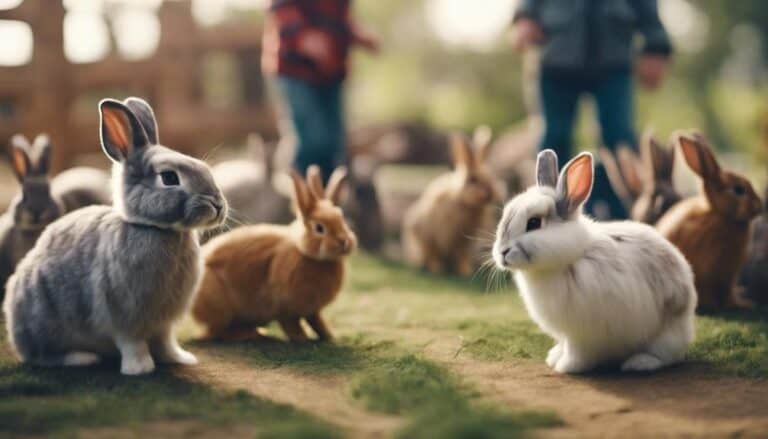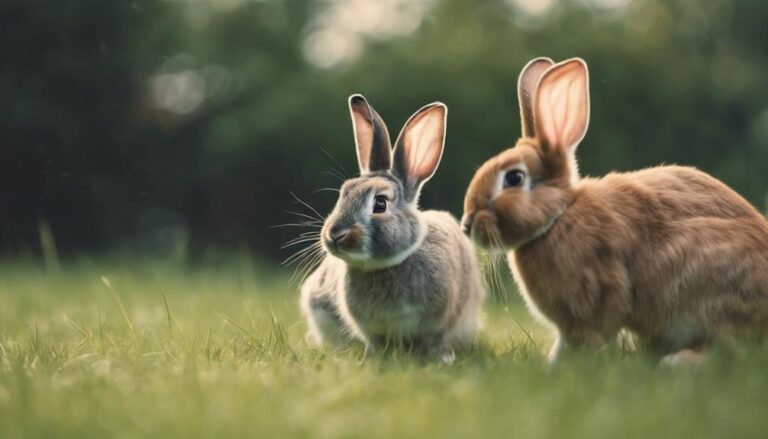Have you ever wondered if bunnies possess the mysterious ability to purr like their feline counterparts?
You might be surprised to learn that the truth behind this question is more complex than you think.
While the concept of purring may seem straightforward, the reality of bunnies and their vocalizations is far from simple.
Stay tuned to uncover the subtle ways in which rabbits communicate and express their feelings through unique behaviors that might just challenge your preconceived notions.
Contents
- 1 Key Takeaways
- 2 Rabbit Vocalizations Explained
- 3 Understanding Rabbit Communication Sounds
- 4 The Myth of Bunny Purring
- 5 Decoding Rabbit Sounds
- 6 Rabbit Purring Debunked
- 7 Can Rabbits Actually Purr?
- 8 Exploring Rabbit Vocal Behaviors
- 9 Debunking the Rabbit Purring Mystery
- 10 Unveiling the Truth About Bunny Purrs
- 11 Can Bunny Shaking be a Sign of Contentment like Purring?
- 12 Frequently Asked Questions
- 13 Conclusion
Key Takeaways
- Bunny purring, indicated by jaw vibration and whisker movement, signifies comfort and emotional bonding.
- Recognizing and understanding rabbit vocalizations deepen the human-rabbit bond.
- Not all rabbits exhibit teeth grinding as a form of purring, showing individual variability.
- Paying attention to subtle cues aids in accurately interpreting rabbit communication and emotions.
Rabbit Vocalizations Explained
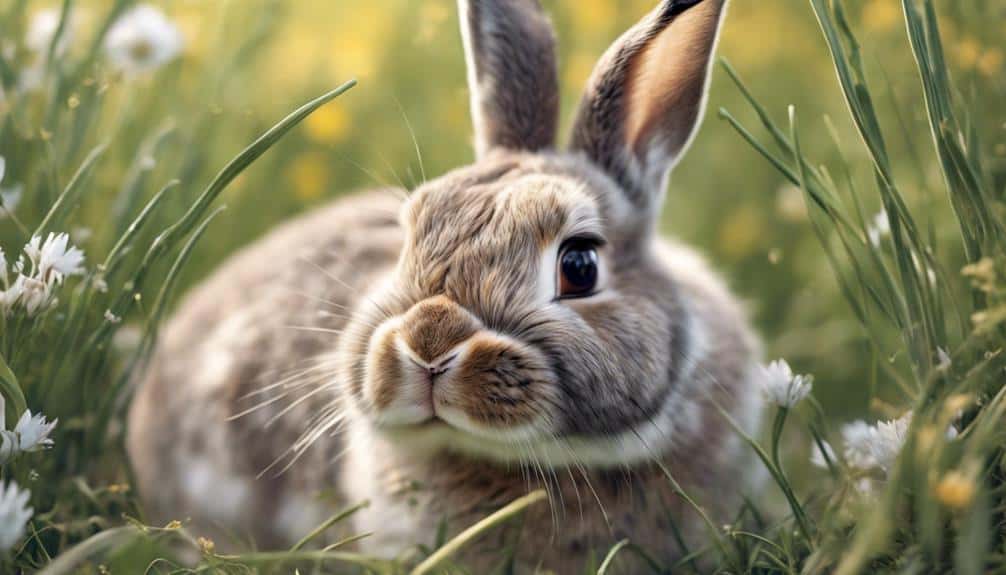
When exploring the domain of rabbit vocalizations, it becomes evident that these furry creatures communicate primarily through subtle sounds and body language. One key aspect of rabbit communication is teeth grinding, which differs from the purring seen in some other animals like cats. Rabbits don't purr in the same way; instead, they express contentment through teeth grinding. This behavior involves light, rapid grinding of the teeth accompanied by jaw vibration and whisker movement.
Teeth grinding in rabbits is often a response to affection, such as petting and cuddling. It signifies that the rabbit is relaxed and comfortable in its environment. However, it's essential to note that not all rabbits purr through teeth grinding, as it depends on their individual personalities and levels of relaxation. Distinguishing between happy purring and distressed teeth grinding is important for rabbit owners, as it can help in understanding the emotional state of these small companions and catering to their needs effectively.
Understanding Rabbit Communication Sounds
Shifting from the discussion on rabbit vocalizations, understanding rabbit communication sounds is key to interpreting your bunny's emotions and needs accurately. When it comes to rabbit purring, here are some essential points to keep in mind:
- Teeth Grinding: Unlike cats, rabbits don't purr conventionally. Instead, they demonstrate contentment through teeth grinding. Happy purring in rabbits is characterized by light and rapid teeth grinding, indicating relaxation and comfort.
- Signs of Distress: Distressed teeth grinding in rabbits differs from happy purring by being slower and harsher. It's important to pay attention to these subtle differences to gauge your rabbit's emotional state accurately.
- Observational Cues: To distinguish between happy purring and concerning teeth grinding, observe your rabbit's jaw vibration and whisker movement. These visual cues can offer valuable insights into your rabbit's feelings, helping you provide the appropriate care and attention they may need.
The Myth of Bunny Purring
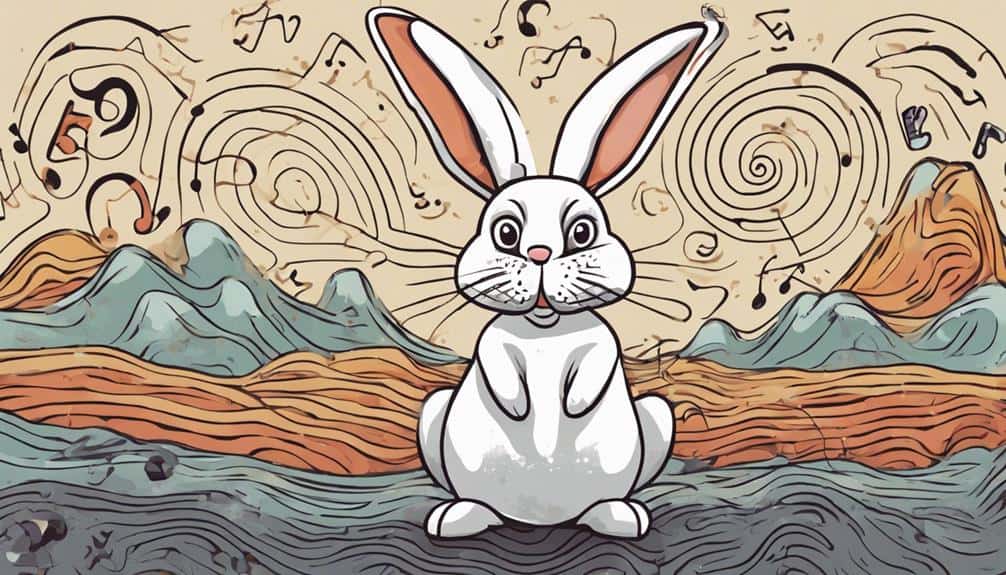
Contrary to popular belief, rabbits do not actually purr like cats; instead, they exhibit contentment through teeth grinding. When you hear your bunny making a rhythmic grinding sound with their teeth, that they are relaxed and comfortable. This behavior is often mistaken for purring due to its soothing nature, but grasp the distinction.
To help clarify the difference between cat purring and rabbit teeth grinding, let's look at the following table:
| Purring (Cats) | Teeth Grinding (Rabbits) |
|---|---|
| Vibrations in the larynx | Rhythmic grinding of teeth |
| Indicates various emotions | Sign of relaxation and comfort |
| Audible sound | May not always be audible |
Decoding Rabbit Sounds
When it comes to decoding rabbit sounds, understanding the nuances of rabbit communication types is important.
By grasping the range of vocalizations rabbits make, you can better interpret their behaviors and emotions.
Recognizing the subtleties of rabbit sounds can deepen your bond with these adorable creatures.
Rabbit Communication Types
Purring in rabbits, a gentle and rapid teeth grinding, signifies contentment and relaxation, often observed during positive interactions such as petting and cuddling. When decoding rabbit communication types, consider the following:
- Body Language: Watch for relaxed posture, half-closed eyes, and gentle movements accompanying purring.
- Frequency: Note how often the rabbit purrs; frequent purring may indicate a deeper level of comfort.
- Environment: Pay attention to where purring occurs; if it happens in familiar and safe spaces, it likely reflects contentment.
Understanding these elements alongside purring can help you decipher your rabbit's feelings and strengthen your bond with them.
Understanding Rabbit Vocalizations
Rabbit vocalizations provide valuable insights into your pet's emotions and well-being, offering a window into their feelings beyond physical cues like body language. When decoding rabbit sounds, understanding the various noises they make is crucial. Below is a table to help you interpret these vocalizations:
| Sound | Description | Meaning |
|---|---|---|
| Teeth Grinding | Lightly grinding teeth rapidly, often with jaw vibration | Contentment |
| Loud Thumping | Forcefully hitting hind legs on the ground | Fear or Warning |
| Grunting | Low, guttural sound made by males during courtship | Territory Assertion or Excitement |
Rabbit Purring Debunked
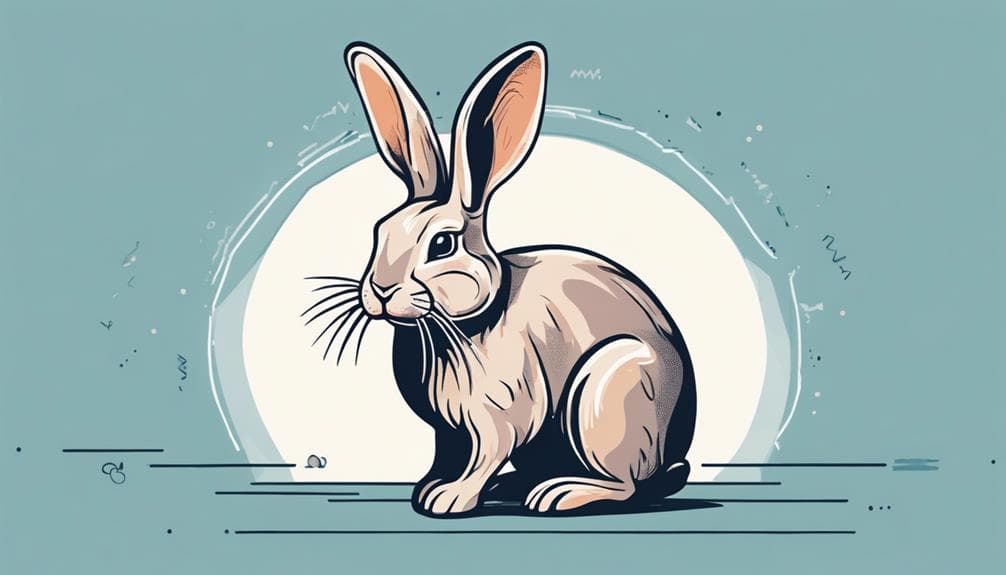
Rabbit purring is often misunderstood as a cat-like purr, but it actually involves a subtle grinding of their teeth. Understanding the key indicators like jaw vibrations and whisker movements can help clarify rabbit purring behavior.
Not all rabbits purr, and it typically occurs in response to affectionate interactions like petting or cuddling.
Rabbit Purring Myth
The misconception surrounding the purring behavior of rabbits is rooted in an assumption of equivalence with feline purring sounds. When caring for rabbits, understanding that rabbit purring is actually a form of teeth grinding is crucial.
To help clarify this distinction, consider the following:
- Picture a relaxed rabbit, content and enjoying affectionate pets, exhibiting light and rapid teeth grinding.
- Imagine observing the rabbit's jaw vibrating gently and whiskers moving subtly in response to this soothing behavior.
- Recognize that this purring-like sound in rabbits signifies their happiness, comfort, and pleasure in your company.
Understanding this myth can lead to better care and a deeper bond with your furry companion.
Purring Sound Explained
Indulging in the soothing sound of teeth grinding, bunnies express contentment through a gentle and rapid purring-like behavior. While rabbits don't purr like cats, they may lightly grind their teeth to convey happiness and comfort. This unique behavior is often accompanied by subtle jaw vibrations and whisker movements.
When receiving affection, such as petting or cuddling, rabbits may exhibit this purring sound, indicating a state of relaxation. Bear in mind that not all rabbits purr, as individual personalities and comfort levels play a role. The exact mechanism behind rabbit purring remains a mystery, underscoring the intricate nature of rabbit communication.
Rabbit Behavior Clarification
Exploring rabbit behavior further beyond the misconceptions surrounding purring reveals intriguing insights into their communication methods and expressions of contentment. When observing a rabbit, you may notice specific behaviors that shed light on their emotions:
- Teeth Grinding: Rabbits express contentment by lightly and rapidly grinding their teeth, a behavior often mistaken for purring.
- Jaw Vibration: Watch for subtle jaw vibrations, which accompany the teeth grinding and indicate a happy bunny.
- Whisker Movement: Pay attention to the movement of their whiskers, as this can also be a key indicator of rabbit purring behavior.
Understanding these subtle cues can help you better comprehend your rabbit's mood and enhance your bond with these delightful creatures.
Can Rabbits Actually Purr?
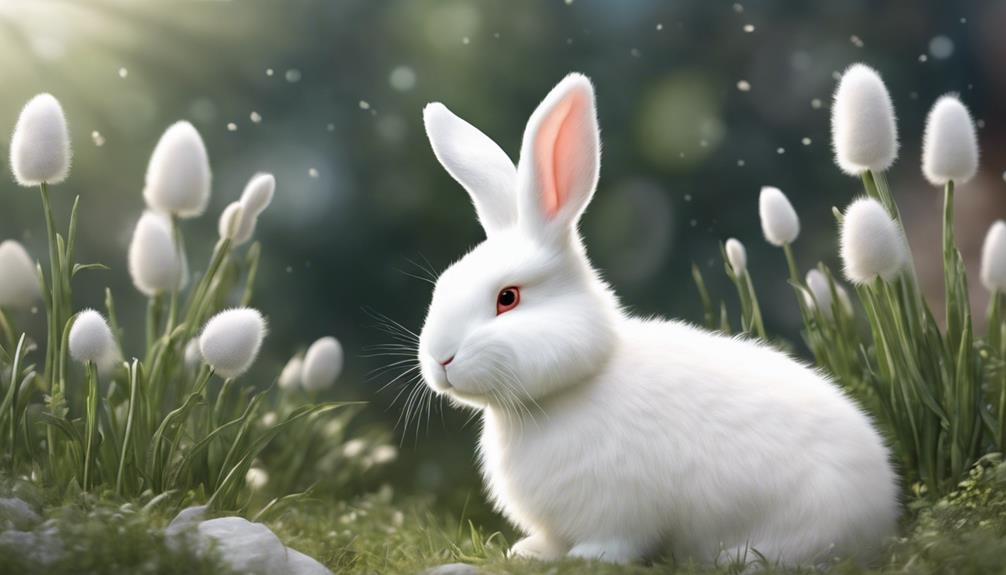
Discussing whether rabbits can actually purr involves understanding their unique way of expressing contentment through a subtle teeth-grinding sound. Unlike cats, rabbits don't produce a traditional purring sound; instead, they lightly grind their teeth when feeling relaxed and comfortable. Observing a rabbit's behavior can provide clues to determine if they're purring. Pay attention to jaw vibration and whisker movement, as these are key indicators of a rabbit's purring behavior. Not all rabbits purr, as it varies based on their individual temperament and level of relaxation.
Rabbit purring is often a response to affection, such as petting and cuddling. This behavior signifies contentment and relaxation in rabbits. While the exact mechanism behind rabbit purring isn't fully understood, this behavior is associated with positive emotions. By recognizing and understanding this subtle form of communication, you can better bond with your rabbit and promote their well-being.
Exploring Rabbit Vocal Behaviors
Rabbit vocal behaviors can provide valuable insights into their emotional state and communication methods. When caring for rabbits, understanding their vocal cues is essential for ensuring their well-being. Here are some key points to consider regarding rabbit vocal behaviors in the domain of Rabbit Care:
- Teeth Grinding: Rabbits may grind their teeth lightly and rapidly as a form of purring, indicating contentment and relaxation. This behavior is akin to purring in other animals and is a positive sign in rabbit care.
- Visual Cues: Observing jaw vibration and whisker movement can help identify when a rabbit is 'purring' due to comfort. Being attentive to these visual signals can aid in understanding your rabbit's emotional state.
- Individual Variability: Not all rabbits exhibit teeth grinding, and it often occurs in response to affectionate interactions. Recognizing the individual variability in this behavior can deepen your bond with your rabbit and improve your Rabbit Care practices.
Debunking the Rabbit Purring Mystery
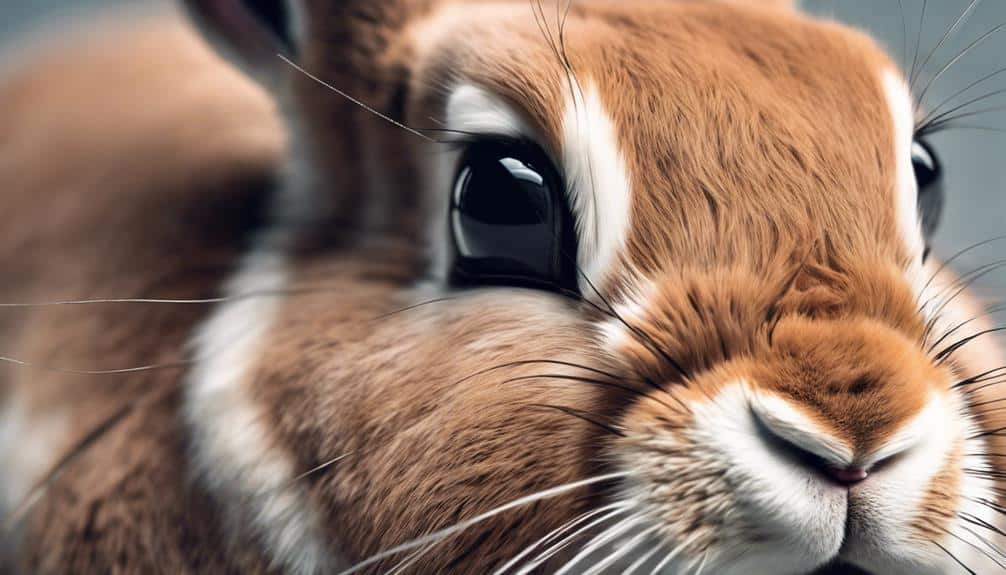
To unravel the mystery surrounding rabbit purring, consider the underlying reasons behind this behavior and how it relates to a rabbit's emotional state. Rabbit purring, often mistaken for the sound of contentment similar to a cat's purr, is actually a form of teeth grinding that causes the rabbit to express comfort or relaxation. This behavior is characterized by rapid and light grinding of the teeth, indicating a positive emotional state. While not all rabbits purr, those that do may do so in response to various positive stimuli such as affection or gentle petting. The exact mechanism behind rabbit purring is not fully understood, but it is commonly associated with contentment and happiness in rabbits.
| Key Points | Description | Impact on Rabbit |
|---|---|---|
| Teeth Grinding Behavior | Rabbit purring is a result of teeth grinding, showing comfort or relaxation. | Indicates positive emotional state. |
| Response to Stimuli | Rabbits may purr in response to gentle petting or affection. | Shows the rabbit's reaction to positive interactions. |
| Emotional Well-being | Purring is linked to contentment and happiness in rabbits. | Reflects the rabbit's emotional state and overall wellness. |
Unveiling the Truth About Bunny Purrs
Expose the truth about bunny purrs by understanding the distinct characteristics of their light and rapid teeth grinding behavior. Bunny purring is a unique form of communication that reflects their emotional state through subtle body language cues. Here are three key aspects to help you decipher the mystery behind bunny purring:
- Jaw Vibration: When a bunny is purring, you may notice a gentle vibration in their jaw. This subtle movement is a clear indicator of their contentment and relaxation.
- Whisker Movement: Observing the movement of a bunny's whiskers can also provide insight into their purring behavior. Whiskers that are relaxed and slightly twitching signify a happy and comfortable bunny.
- Response to Affection: Bunny purring often occurs in response to affectionate gestures such as petting and cuddling. Pay attention to their purring behavior as it can indicate their level of comfort and bond with you.
Can Bunny Shaking be a Sign of Contentment like Purring?
Bunnies shaking behavior explained: Bunny shaking can indicate contentment, just like purring in cats. When bunnies are relaxed and happy, they may shake their bodies as a sign of contentment. This behavior is often seen after stretching, grooming, or when they are receiving pets and cuddles from their owners.
Frequently Asked Questions
What Does It Mean When Your Rabbit Purrs?
When your rabbit purrs, it generally means they're content and relaxed. Purring behavior often accompanies affectionate interactions like petting. Not all rabbits purr, as it varies per rabbit. Recognizing this happy sound is important for rabbit owners.
What Do Bunny Purrs Sound Like?
Bunny purrs sound like a gentle, rhythmic grinding of teeth. The purring frequency varies among rabbits, with some purring more frequently than others. Understanding this sound can help you connect with your bunny's emotions and well-being.
Do Rabbits Purr When Happy?
When you see rabbits tooth purring, they're expressing happiness and comfort. This rhythmic tooth grinding signifies contentment and relaxation. Observing this behavior helps you understand your bunny's emotional state and well-being, enhancing your bond.
Do Rabbits Vibrate When Purring?
When rabbits purr, they exhibit vibrating behavior through jaw movement and whisker activity. This gentle vibration is a sign of contentment and relaxation. Not all rabbits purr, but those that do show this unique behavior as a response to affection.
Conclusion
So, now that you know bunnies don't actually purr, isn't it fascinating to discover how they communicate through tooth grinding?
Understanding rabbit vocalizations can deepen your bond with these adorable pets and guarantee you provide them with the care they need.
Keep listening for those subtle sounds and watch for their whiskers twitching – you'll be amazed at how much rabbits can express without saying a word.

